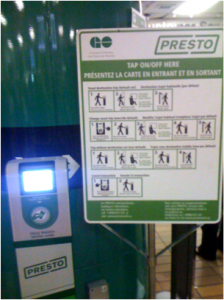I’m in Toronto for the EuroFinance conference which has the additional benefit of letting my try out the new PRESTO contactless fare system run by the Government of Ontario for GO Rail that brings commuters into Toronto. The system is being rolled out as a closed loop contactless program with a tap and go approach and is currently being used by more than 10,000 commuters across the Greater Toronto and Hamilton Area (GTHA).
 I loaded money to the PRESTO Card from my US magnetic swipe credit card (at a point of sales device that was also CHIP & PIN enabled). Once the funds were loaded and a default trip set, I could tap and go – both at the Go Station and then again in Toronto to get on the subway. I did not need to pull the card out of my wallet but rather put my wallet near the green circle and it registered the card and deducted payment. It was great to not have to line up in the fare line. I walked right through the subway station in the middle of morning rush hour and onto the tracks. It was faster than fumbling for a token and much faster then standing in line to pay.
I loaded money to the PRESTO Card from my US magnetic swipe credit card (at a point of sales device that was also CHIP & PIN enabled). Once the funds were loaded and a default trip set, I could tap and go – both at the Go Station and then again in Toronto to get on the subway. I did not need to pull the card out of my wallet but rather put my wallet near the green circle and it registered the card and deducted payment. It was great to not have to line up in the fare line. I walked right through the subway station in the middle of morning rush hour and onto the tracks. It was faster than fumbling for a token and much faster then standing in line to pay.
The biggest challenge facing the implementation is the conflicting request for proposal from Toronto Transit Commission (TTC) that runs the subway, streetcar and bus service in Toronto. The TTC has a vision for an open system allowing customers to use their debit or credit card for payments.
The reality is that the TTC does not have funding to afford the full implementation of PRESTO across its transit system and is looking for a third party – for profit – provider to make money on the payment transactions. Under the PRESTO plan the Province intended to pay only one third of the cost to implement across the TTC system. The TTC is soliciting bids for an open payment system partner and threatening to withdraw from PRESTO. The Toronto Sun provides an interview with Kathleen Wynne, Minister of Transportation for Ontario (Video) from the PRESTO perspective. (Toronto Star Article).
Open transit systems have not been broadly implemented in the North American market; currently New York is running an initial trial. Conceptually having the cards already in wallet sounds inexpensive and convenient, but the tracking of electronic fares and checking fares on a train creates complexity. The long-term vision with the new vendor needs to be for one system in order for commuters to attain the benefits of a single transit card across transit systems.

